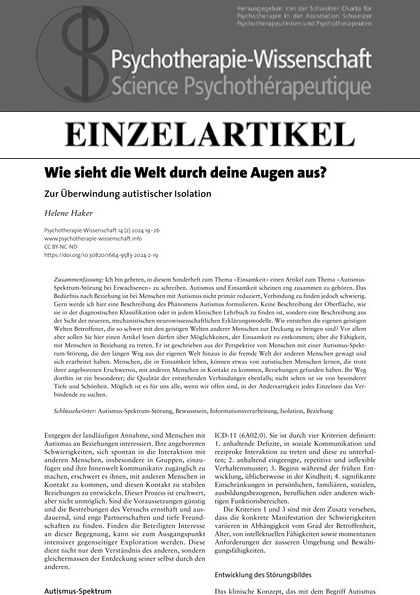What does the world look like through your eyes?
Overcoming autistic isolation
DOI:
https://doi.org/10.30820/1664-9583-2024-2-19Keywords:
autism spectrum disorder, consciousness, information processing, isolation, relationshipAbstract
I have been asked to write an article on «Autism Spectrum Disorder in Adults» in this special issue on «Loneliness». Autism and loneliness seem to go hand in hand. The desire for relationship is not primarily reduced in people with autism, but finding a connection is difficult. I will formulate a description of the phenomenon of autism. Not a description of the surface, as it can be found in the diagnostic classification or in every clinical textbook, but a description from the perspective of the newer, mechanistic neuroscientific explanations. How do the idiosyncratic mental worlds of affected individuals develop, which are so difficult to reconcile with the mental worlds of others? Above all, however, you should be able to read an article here about ways to escape loneliness; about the ability to enter into relationships with people. It is written from the perspective of people with an autism spectrum disorder who have travelled the long and stony way out of their own world into the strange world of other people. People who live in loneliness can learn something from people with autism who have found relationships despite their innate difficulty in socialising with others. The path they take this is a special one, as is the quality of the resulting connections, which are often of particular depth and beauty. It is possible for all of us if we are open to finding what connects us in the differences of each other.
Downloads
How to Cite
Haker, H. (2024). What does the world look like through your eyes? Overcoming autistic isolation. Psychotherapie-Wissenschaft, 14(2), 19–26. https://doi.org/10.30820/1664-9583-2024-2-19
Issue
Section
Special Issue
License

This work is licensed under a Creative Commons Attribution-NonCommercial-NoDerivatives 3.0 Unported License.
This journal provides open access to its content in accordance with the basic premise that the free public availability of research benefits the exchange of knowledge throughout the world.
Authors wishing to publish in this journal agree to the following:
- The author/s retain/s the copyrights and consent/s to initial publication of the work in the journal under a Creative Commons Attribution licence, which allows third parties to use the work by citing the name/s of the author/s and this journal as initial publisher (in accordance with the Creative Commons Attribution-NonCommercial-NoDerivs 3.0 DE-Licence).
- The author/s can enter into additional contracts for the non-exclusive distribution (e.g. publish in a collection or book) of the version published in the journal, if the journal is cited as initial publisher.


